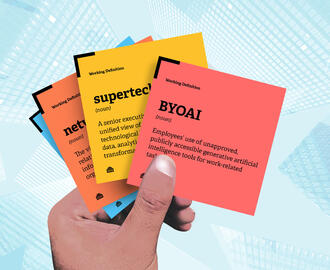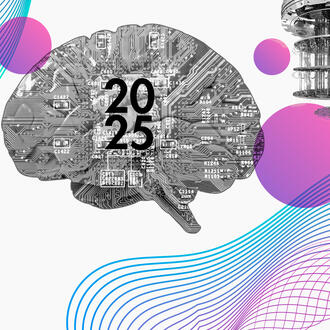Credit: Carolyn Geason-Beissel/MIT SMR | Getty Images
AI implementation strategies: 4 insights from MIT Sloan Management Review
What you’ll learn:
- Apollo Global Management is assessing AI value across entire industries to cut costs and improve productivity in its portfolio companies.
- Michelin’s proof-of-concept approach has identified 200-plus AI use cases that generate 50 million euros in ROI annually.
- “Vibe analytics” can help leaders get data insights in minutes instead of weeks.
- A new framework examines four modes of human-robot collaboration in warehouses.
When implementing artificial intelligence, enterprise leaders must consider where AI will create value, not just where it will be useful. The latest ideas from MIT Sloan Management Review illustrate how to make this happen in verticals as varied as manufacturing, publishing, cybersecurity, and e-commerce — with specific takeaways for warehouse operations.
Assess AI’s impact across an industry
One important sign that AI has the potential to create value is the willingness of private equity firms to build AI capabilities into portfolio companies, according to Thomas H. Davenport, a research fellow with the MIT Initiative on the Digital Economy. Consider how Apollo Global Management has taken AI from pilot to production to scale across its portfolio:
- Educational publisher Cengage has cut content production costs by 40% and lead generation costs by 20% through process automation.
- At Yahoo, AI-generated code has helped engineering teams improve productivity by more than 20%.
- Chemical distributor Univar Solutions achieved a 30% engagement rate with an AI agent that reached out to dormant accounts.
Apollo starts by evaluating AI’s risks and rewards at a macro level — assessing how AI is impacting not just the target company but its entire industry. Davenport and co-author Randy Bean write that this helps Apollo avoid high-risk scenarios and ensure that innovation happens in the right place at the right time. Next, Apollo develops AI use cases for the target company and crafts a post-acquisition implementation plan.
Apollo also partnered with a venture capital firm to launch an incubator for B2B AI startups that includes companies focused on supply chain resiliency, manufacturing response time, and a range of other AI capabilities. The expectation is that the startups will eventually provide services to Apollo’s portfolio companies.
Read: ‘Building AI capabilities into portfolio companies at Apollo’
Find AI’s value at proof of concept
For some enterprises, AI efforts focus on core business processes. For others, it’s all about innovation from the ground up. Multinational manufacturer Michelin Group has managed to do both. In a second analysis, Davenport and Bean highlight how Michelin is accelerating manufacturing innovation, with more than 200 AI use cases across quality control, inventory management, and predictive modeling.
The primary lever for AI adoption, group chief data and AI officer Ambica Rajagopal said, is identifying potential value at the proof-of-concept stage. Rajagopal’s team also conducts a post-deployment assessment of the actual value delivered.
From there, Michelin’s innovation team of 6,000 employees across 13 countries gets to work. All told, improved productivity from AI projects now generates more than 50 million euros in ROI per year, with a growth rate increase approaching 40% annually. That has helped Michelin empower employees in all roles to harness data, create value, and support the company’s growth.
Read: ‘Accelerating manufacturing innovation at Michelin with data and AI’

Leading the AI-Driven Organization
In person at MIT Sloan
Register Now
Empower leaders to ask questions to data sets
If leaders could get data insights in minutes instead of weeks, they would be well positioned to determine which initiatives show the most promise. Michael Schrage, a research fellow with the MIT Initiative on the Digital Economy, examines an approach dubbed “vibe analytics.” This approach lets decision makers engage directly with data through AI-powered conversation, eliminating the traditional translation process between business questions and technical analysis.
The concept builds on “vibe coding,” an AI-assisted approach that lets people create code using everyday language. Vibe analytics allows leaders to ask questions like “What’s happening with our conversion rates?” and immediately explore potential causes through improvisational dialogue with AI.
Vibe analytics stands to democratize how knowledge is generated in organizations, Schrage writes. Instead of waiting for static reports, leaders can start a direct dialogue with messy data. And teams can turn KPIs into conversational partners and debug assumptions in real time, accelerating decision-making while revealing unexpected patterns.
Employing vibe analytics, a Southeast Asian telecom company surfaced more financially relevant insights in 90 minutes than it typically generates in 90 days, developing a novel scoring system that reveals which service contracts correlate with higher margins and risks. Meanwhile, a cybersecurity firm discovered actionable patterns in its freemium customer base that its revenue team hadn’t considered.
Read: ‘Vibe analytics: Vibe coding’s new cousin unlocks insights’
Help robots and workers get along
While teams of robots and humans are increasingly common in warehouses, effective collaboration remains elusive. Workers struggle to keep pace with robots that rarely need breaks, and they get frustrated with rigid automated systems. Slowing robots down or taking them offline entirely is good for morale but bad for cost management.
With that in mind, Benedict Jun Ma and Maria Jesús Saénz at the MIT Digital Supply Chain Transformation Lab created a framework to describe human-robot collaboration in warehouses and distribution facilities, where they see AI becoming a critical tool for improving how humans and robots work together. They begin with four modes of collaboration:
- Robot-in-lead, ideal for unloading cargo and picking simple orders (such as in a shoe warehouse).
- Human-in-lead, helpful for packaging orders (especially for high-value items).
- Elementary collaboration, where robots gather items for workers to sort.
- Advanced collaboration, where AI helps robots better match human speed and strength, as well as forecast and manage disruption.
As the authors note, AI is vital to advanced human-robot collaboration. It gives robots contextual awareness, such as the processing of fragile goods that require special handling; it also optimizes robots’ movement through the warehouse and supports audio or visual communication with human workers. AI models can also assess robots’ performance, recommend adjustments, and provide alerts to human workers.
Read: ‘AI can improve how humans and robots work’
This article draws on insights from MIT Sloan Management Review, which leads the discourse about advances in management practice among influential thought leaders in business and academia. The publication equips its readers with evidence-based insights and guidance to innovate, operate, lead, and create value in a world being transformed by technology and large-scale societal and environmental forces.




